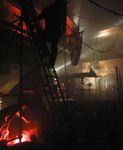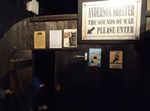WINSTON CHURCHILL'S BRITAIN AT WAR EXPERIENCE
←
→
Page content transcription
If your browser does not render page correctly, please read the page content below
Winston Churchill’s Britain at War Experience London, England Katherine Rossy Department Of History Concordia University South of London Bridge on Tooley Street lies Winston Churchill’s Britain at War Experience, a museum whose slogan “See it, Feel it, Breathe it: the Adventure of War-torn London” promises a plethora of unique sensory experiences. The museum’s exterior is covered with massive Second World War propaganda posters, which immediately recreate the heavy atmosphere of the London Blitz. From the moment the visitor steps foot inside the building, he is taken back in time to September 1940, and cautiously makes his way down a musky corridor to an industrial steel elevator. The doors clang shut, and the visitor begins the descent into the deep, dank Londonian abyss. (See figure 1) The elvator doors open and the visitor finds himself in a reconstructed London Un- derground. He immediately learns that the space has been transformed into an ersatz air-raid shelter. Anxious and disheveled civilians take refuge from the devastating aerial assault of Nazi Luftwaffe planes overhead. The thundering of bombs shakes the room’s foundations and rattles the wooden bunk beds that line the far wall. (see figure 2) Anxious Londoners, ravaged by war, huddle together beneath soot-caked bed sheets as they attempt to filter out the imploding sensory overload of the bomb shelter. Food rations and provisions, from the YMCA, are laid on a table nearby to relieve the civilian refugees. A short film is projected onto the wall ahead and shows footage of the London wreckage; it is then followed by a short chronology of the London Blitz. Emo- tionally charged testimonies are delivered with shaky voices to give the visitor insight into the magnitude of civilian plight. (see figure 3) THE SENSORY MUSEUM PROJECT 1
Figure 1: a sign directs visitors towards the lift Figure 2: civilians take refuge in the London
underground
Figure 3: provisions attempt to ease civilian Figure 4: a BBC hub reports the latest news of
plight the London Blitz
A narrow corridor leads the visitor toward a near-abandoned BBC radio hub, where
newscasts from London, Rome, Washington, and Berlin report the latest local and in-
ternational news about the war. (see image 4) Visitors are invited to listen to milestone
speeches by Roosevelt, Chamberlain, Churchill, and Hitler, who beseech their respec-
tive nations to sustain the war effort despite the overwhelming desire to abandon it.
Newspaper clippings adorn the narrow walls of the space, forcing visitors to piece
together the chaotic events on the home front just as civilians were often forced to
rely on days and weeks-old news between 1940 and 1945. The visitor hesitatingly
continues on and peers into Dame Vera Lynn’s dressing room, an iconic celebrity of
1940s England, for words of support. He is then beckoned towards Anderson’s Shelter,
a reconstructed air raid shelter designed to give him a sense of the terror that ripped
through Londonian society during the Blitz. (see image 5) As soon as he enters the
claustrophobic, metal dome, he is immediately plunged into darkness. Eerie air raid
THE SENSORY MUSEUM PROJECT 2warning sirens wail overhead, becoming progressively louder and louder. Suddenly,
bombs are heard in the distance. The bombings rapidly crescendo as Luftwaffe
planes near the location of the shelter, resonating incessantly until they finally reach
a deafening silence. (see image 6) The isolation and darkness of Anderson’s Shelter
forces the visitor to rely only on his sense of hearing in order to fathom the extent of
the destruction that was unfurling above him.
Figure 5: A unique sensory experience awaits in Anderson’s bomb shelter
Figure 6: The visitor is forced to rely on his sense of hearing upon being
submerged in darkness in the bomb shelter
Upon exiting the bomb shelter, the visitor walks disorientingly toward a corner table,
where he is encouraged to interact and engage with authentic artifacts, and relics such
as gas masks and helmets. Musky, disheveled mannequins of working mothers and
young children soon follow, and audio accompaniments deliver haunting recollections
of the hardships that civilians often faced on the home front. (see image 7) Here, the
visitor learns of the plight of working women who laboured long hours in armaments
THE SENSORY MUSEUM PROJECT 3and munitions factories to sustain the war effort. He also learns that many mothers
and their families often waited many long months to be assigned to new homes after
the systematic destruction of countless neighborhoods.
Figure 7: Visitors can engage their senses by interacting
with artifacts and relics
Soon thereafter, the visitor is transported to the home front, where he goes window-
shopping in Southwark, one of the oldest parts of Central London. The dimly lit streets
cast shadows over the air-raid warning signs that plaster the red brick walls, constantly
reminding the visitor of the imminent threat that loomed overhead. Artifacts, such as
food staples and clothing, meagerly fill store windows with their prices in pounds and
shillings displayed unabashedly beneath. (see image 8) Most astounding, however, is
a window display on wartime weddings, where a wedding cake is advertised for rent.
The visitor learns that the bride and groom could rent such a cake for their wedding
ceremony but could not actually serve it to their guests, since flour and sugar were in
extremely short supply and not readily available to civilians.
Figure 8: The visitor gets insight into the hardships of wartime rashioning
THE SENSORY MUSEUM PROJECT 4After he has finished window-shopping, the visitor comes face to face with Prime
Minister Winston Churchill, who is hard at work at his desk at either 10 Downing Street
or in the Cabinet War Rooms, Her Majesty’s Government’s secret bunker beneath par-
liament. Here, the visitor listens to Churchill as he delivers milestone speeches in his
typical, charismatic style. He soon comes to realize that these enduring Second World
War speeches played an integral role in boosting the Londoners’ morale during one of
the most arduous periods in modern British history. (see image 9)
Figure 9: Prime Minister Churchill lifts the civilian morale through rhetoric
After leaving Churchill’s office, the visitor enters the Rainbow Corner where boister-
ous American GIs drink and entertain themselves into the early hours of the morning.
Music plays overhead and sounds of laughter laced with anxiety overshadow their
seemingly carefree exteriors. One soldier eagerly charms a young lady while another
bangs away on the piano, filling the room with lively music. (see image 10) An American
flag is draped patriotically overhead and becomes the focal point of the room. It serves
as a stark reminder of the United States’ crucial participation in the Second World War
as well as the affinity between Prime Minister Churchill and President Roosevelt.
Figure 10: The seemingly carefree demeanor of American GIs in the Rainbow Room
THE SENSORY MUSEUM PROJECT 5Nearby, an arrow-shaped sign reading “London Blitz This Way” immediately
commands a sense of urgency. A heavy, cumbersome atmosphere weighs down the
visitor. The seemingly carefree, laidback ambiance of the Rainbow Room is suddenly
swept away by tension. The visitor hesitantly approaches a closed door, under which
menacing smoke billows and swirls around his feet. He slowly opens the door and
enters a smog-filled corridor. Cautiously, he follows the lights on the floor as a loud
voice warns visitors to mind their step. (see figure 11) Acrid smoke immediately swirls
into his mouth and nose and fills his lungs. His vision is clouded; he can barely decipher
what lies ahead. A fire hydrant violently juts a powerful stream of rushing water into
the air, the intensity of its sound only second to the consistent sound of explosions.
The earth trembles beneath the visitor’s feet as he makes his way toward the site of
the wreckage. As he approaches the epicenter of the wreckage, the air becomes more
heavily saturated with smoke and fear. (see figure 12) Tepid water vapor chokes the
Figure 11: the visitor enters the London Blitz Experience
Figure 12: The visitor is plunged into a maelstrom of death and destruction
THE SENSORY MUSEUM PROJECT 6visitor as he passes by a heap of glowing embers, the remains of a building. Suddenly,
the visitor is in the midst of the London Blitz.
An overwhelming collection of sensoria envelops him and distorts his senses to
create a hyper-sensualized bombsite. (see figure 13) The façade of a pub, its window
completely shattered, is blackened with soot and debris and tinged by flames. A
severed arm is sprawled on the ground; the rest of its body is nowhere to be found. A
noose looms imposingly over-head with a sign that reads, “Reserved for Hitler”, and
immediately darkens an already somber mood. The visitor is faced with a most unex-
pected reality: the London from which he came before entering the museum was once
in an utter state of ruin. He stumbles from the epicenter, and can still hear the faint,
eerie wails of air raid warnings. (see figure 14)
Figure 13: The smoky remains of an English pub
The visitor leaves the maelstrom of fire and rubble with an enduring sense of the
terror that gripped London in September, 1940. As he leaves the building, he is greeted
by a grey, foreboding sky on the banks of the river Thames. His senses seemingly
assaulted, he emerges from the sobering experience profoundly changed. Passing by
a double decker bus, he walks to the nearest pub for a pint of reality. (see figure 15)
THE SENSORY MUSEUM PROJECT 7Figure 14: A sobering symbol of civilian resistance
Figure 15: Heading for a pint of reality
THE SENSORY MUSEUM PROJECT 8You can also read



























































